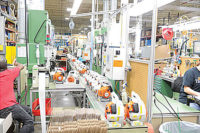
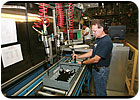
The 2007 Assembly Plant of the Year builds 2 million residential load centers annually.
The typical load center is a plain metal box that most people never think about, unless their television, computer, refrigerator or air conditioner suddenly stops working. Yet millions of homes throughout North America contain these small gray boxes, and the vast majority of them sport a big “D” inside a square. The boxes house an assortment of bus bars and other aluminum, copper and plastic components that distribute and control low-voltage electricity.
Contractors and builders buy the boxes and electricians stuff them with different types of circuit breakers, depending on the application. For instance, a 2,000-square-foot ranch house would require a different amount of protection than a three-story, 4,000-square-foot colonial.
Without load centers, homes would not be protected from electrical overloads and short circuits. It’s a simple solution to a potentially deadly problem. Although most load centers look the same, they’re not. A wide variety of options are available. In fact, assemblers at the Lexington plant build 200 different types of load centers.
The Lexington plant has been making load centers and safety switches since Dwight D. Eisenhower was president. The facility, which recently celebrated its golden anniversary, is the recipient of ASSEMBLY magazine’s fourth annual Assembly Plant of the Year award.
The Lexington plant features state-of-the-art production equipment, such as smart parts bins, torque monitoring systems and robotic palletizers. But, when it comes to manufacturing philosophy, the plant is old school. Vertical integration is alive and well. Indeed, all injection molding, metal stamping, plating and painting is done in-house, in addition to packaging.
Combined with lean manufacturing initiatives, the unique approach is paying off. The plant achieved 20 percent growth in volume between 2002 and 2006.
“The plant is very lean in terms of landed cost in comparison with our competitors,” says Ken Engel, vice president of manufacturing excellence and strategy at Schneider Electric’s North American operating division (Palatine, IL). Engel previously served as plant manager of the Lexington facility. “Being vertically integrated helps keep our manufacturing lead times and costs low. Due to our intense focus on continuous improvement, we have a high level of focus on overall equipment effectiveness.”
Over the last seven years, the plant has experienced a 6.7 percent annual improvement in labor productivity. Due to automation projects that were installed during the mid 1990s, Square D load centers and switches are often viewed as being the highest quality products in the industry.
“This has allowed our Lexington facility to continue to stay competitive and keep our manufacturing closer to our customers,” notes Engel. “The reason for this success is largely due to our focus on continuous improvement through the tools and processes of the Schneider Production System.”
That allows the 50-year-old Square D plant to remain safety-oriented, customer-focused, quality-driven and productive as it strives to achieve the Schneider Electric mission: “Give the best of the new electric world to everyone, everywhere, at any time.”
A Proud Heritage
The Square D name has been around for more than 100 years. It traces its heritage to the Detroit Fuse and Manufacturing Co., which produced a popular safety switch with the letter “D” stamped on the cover. Square D introduced the first residential circuit breaker panel in 1936, which eliminated pesky fuse boxes.In 1991, the company was acquired by Groupe Schneider (Paris, France) and Square D became its brand name in the U.S. market. Today, Schneider Electric is one the world’s largest suppliers of equipment used for electrical power distribution in residential, industrial and commercial buildings. The company is also a leading provider of industrial automation and control.
Schneider Electric is a $17 billion company that was founded in 1836 and operates in 130 countries around the world. The North American operating division accounts for 27 percent of the parent company’s total revenue.
Even though the company has 17 plants in China, Schneider Electric has been able to continue to keep production close to its customers. According to Engel, the company’s philosophy is to “produce as close to customers as possible to improve service quality and responsiveness.”
Some of its competitors have shifted production offshore, but the company continues to invest in domestic plants. For instance, Schneider Electric is currently spending $9 million to upgrade the Lexington plant.
Since the plant opened in 1957, it has changed dramatically. The facility has been enlarged four times, adding more than 300,000 square feet to become one of Square D’s largest plants.
If a manufacturing engineer or operator frozen in time 50 years ago suddenly reappeared today, they might not recognize the plant. “Five decades ago, some safety practices were not as emphasized as they are today,” explains Spence. “Smoking was permitted throughout the building, product was built in large batches, and workers built up an entire load center at a bench with a lot of inventory around the bench.
“There were no computers to aid in scheduling and material management,” adds Spence. “With significantly more employees than today, employees worked shoulder to shoulder with noise from presses and paint smell throughout the plant.”
In the old days, work in process (WIP) was located all over the plant. “Some folks who were here say it was hard to get down the aisles,” notes Spence. “We had well over 1,600 workers at one point in time vs. around 400 employees today.
“We are much more efficient now, as we put out more product at 400 employees than we did with over 1,000,” adds Spence. “Today, we still have some smart WIP in strategic locations, but material is organized. And, due to 5S, everything is easy to locate for our employees.”
Prior to 1995, load centers and safety switches were built in large batches, increasing lead times and reducing efficiency. Over the last 12 years, the plant has invested in all areas of fabrication and assembly to remove approximately 113 minutes of process lead time.
The 2007 Assembly Plant of the Year builds an average of 8,000 load centers and 3,500 safety switches every day, using two shifts. Safety switches are primarily used in industrial and commercial settings, while load centers are intended for residential applications.
Operators assemble two main families of load centers. The QO (Qwik-Open) is the plant’s premium product. It contains copper bus bars and shielded bus. The other type of load center is called Homeline. It’s a lower-cost product that uses aluminum bus bars to keep the price more competitive.
Demand for load centers is driven by new-home construction, which makes the electrical distribution products industry extremely competitive. For instance, the recent downturn in the U.S. housing market has affected demand.
“The recent slowdown has elevated the need for continuous improvement to an even higher level,” says Engel. “So, the Lexington facility [must] continue to strive for perfection to find new ways to achieve the next level of manufacturing excellence.
“The market for load centers and safety switches is more competitive than in the past,” adds Engel. “Customers appreciate U.S.-made product, but they will still buy the best value. Our competitors are constantly looking for improvements in cost. What has set us apart from our competition with these products is superior quality and customer service.”
Customers include contractors, remodelers, builders and home owners. Traditionally, Square D has shipped its products to electrical supply distributors, who sell to electricians and building contractors. However, in recent years, it has been selling more and more through retail channels, such as home improvement centers and big-box retailers like Home Depot, Lowe’s and Menards.
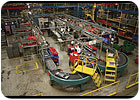
Lean manufacturing has helped keep Schneider Electric/Square D Lexington competitive in the United States, while some of its competitors have moved operations offshore.
Vertical Integration
Today, many manufacturers have outsourced as much upstream production processes as possible. But, that’s not the case at Schneider Electric/Square D Lexington. The plant is virtually self-sufficient. While lugs, clips and fasteners are purchased, just about everything else that goes into a load center or safety switch is produced in-house. In fact, the facility even produces parts that are shipped to sister plants, which make circuit breakers and other types of electrical distribution products.“Very few manufacturing facilities are as vertically integrated as [this plant],” says Spence. “Our core competencies include metal fabrication and welding, electro deposition painting, tin plating, thermoplastic molding and semiautomated assembly. These competencies allow us to convert raw material into final assemblies at an astounding pace of one unit every 7.5 seconds for load centers.”
Metal fabrication for the Lexington plant starts with the processing of coil-fed material delivered on a daily basis to flexible fabrication machines that convert the raw material into critical components used in final assembly. For example, a typical electrical enclosure will begin as an 18,000 pound coil. In a matter of seconds, stamping and automated welding processes convert the raw material into a welded box assembly. Variation in customer demand can be met by changing the size of the enclosure. This happens in seconds through the use of PLCs and programmable tooling.
After the enclosures have been fabricated and welded, they are processed through an electro deposition painting bath. The painting system consists of a multistage pretreatment system followed by an emersion bath and subsequent bake operation.
“Our continuous improvement efforts have allowed for quicker processing times, which reduces energy consumption including water, electricity and natural gas,” explains Bruce Molinar, senior manufacturing engineering manager. “In 2006, our energy consumption came in under budget by approximately $200,000.” Total square footage painted averages 49 million annually. Outside of the automotive industry, this represents a significant paint volume, claims Molinar, a former engineer at Ford Motor Co. (Dearborn, MI).
In addition to painting, the Lexington plant boasts a world-class plating process that tin plates approximately 1 million pounds of aluminum and 2 million pounds of copper annually. “This process is environmentally friendly and is unique to the industry in that we utilize cyanide-free chemicals,” says Molinar. “Cyanide-free plating represents less than 10 percent of industry plating processes today in the United States.”
Cyanide-free plating is one example of how the plant has been able to maintain ISO 14001 certification for environmentally friendly manufacturing. In addition to cyanide-free plating, the Lexington plant has removed hexavalent chromium from its plating processes.
Plastic injection-molding is another core competency that is unique to the Lexington facility. This large in-house operation is supported by five hourly associates per shift operating 21 mold machines 24 hours per day, five days per week. Quick tool changeovers, standardized tooling, and silo fed material allow this area to process approximately 3.5 million pounds of thermoplastic material annually. The molding operation supports additional Schneider Electric facilities in low-cost countries on three continents.
Demand-Driven Assembly
The Lexington plant’s semiautomated assembly process has evolved from manual fabrication, manual assembly, manual packaging, batch processing, quality inspection and MRP scheduling to a facility supported by a multitude of lean manufacturing processes. “The transition took a significant turn during the early 1990s, when management began to make significant investments in capital equipment and new assembly processes,” says Engel.For instance, over the last seven years, the plant has consolidated many manually operated stations into larger, faster automated systems. New machine centers utilize automation to consolidate stamping, cutting and welding operations into an in-line process that reduces changeover times and increases productivity. These systems employ methods such as automatic die changes, servo-fed steel coil processing, automatic steel sheet calculations to minimize scrap, robotic MIG welding and coordinated axis bending.
The current assembly lines utilize a variety of technologies to improve safety, customer service, quality, and productivity. “The technology path begins with the customer and migrates throughout the process to ultimately achieve service levels in excess of 97 percent on a consistent basis,” notes Spence
Production occurs on six main assembly lines. Key components of residential load centers include a three-piece metal box with a hinged door and two or three copper or aluminum bus bars that are either encapsulated or heat staked to the load center interior.
Assembly line activity is driven by customer demand. Warehouse inventories across North America are updated every 90 minutes with actual values based upon current shipments. Software programs allow plant-floor management to accurately schedule daily production requirements. Simple color coding of catalog references at various inventory levels defines the correct order priority.
A final assembly scheduling (FAS) software package was developed in-house. “Orders from our customers and sales team are all entered into quote to cash (Q2C) software,” explains Molinar. “Expectations from our customers are entered into Q2C, such as delivery, quantity and ship destination. FAS then extracts this data and prioritizes catalog numbers at a specific assembly bench level.
“Color coding within FAS is utilized to allow group leaders and supervisors to build only what is needed,” adds Molinar. “The FAS system puts customer demand information in the hands of the people building our product, allowing them to make the best decision for the customer and ensuring customers get what they want, when they want it.”
Once order priorities have been established, the teams begin the process of scheduling the work. After implementing a MRP system in the 1980s and a kanban material management system in the 1990s, the facility now utilizes a fabrication execution system (FES) to support a pull system from fabrication to assembly groups within the plant.
“Both FAS and FES improve the order and replenishment process to meet customer demand,” says Molinar. “Specific order production quantities are scheduled, and with that the actual assembly process begins.”
Assembly takes place in a similar fashion on all of the semiautomated assembly lines. Conveyors move parts and components from station to station. Electronic work instructions deliver accurate part and orientation images to operators to ensure that quality is built into the final assembly. Photos serve as a visual aid and change when the catalog number being produced changes.
“These work instruction changes are linked to an electronic bill of material,” notes Molinar. “Recently, we added takt time counters that change color to yellow at 80 percent of the takt time limit and red when an operator goes over their takt time for that catalog number, based on the product routing time.”
Smart bins error-proof assembly and confirm that each component is correctly picked according to the bills of material. The bins light up as the product moves down the conveyor, signaling a demand for a specific component. A failure to choose from the correct bin will result in an error message via an andon light or LED located on the bin.
“The error-proof system features are integrated into the design of the product and also enhance the assembly operation,” Molinar points out. “As an example, molded and stamped components are designed to fit in a specific orientation. All molded components are designed for ease of assembly.”
Screwdriving is a critical part of production at Schneider Electric/Square D Lexington. “The assembly process requires the use of a wide variety of fasteners,” says Molinar. Many different types of angle, straight and pistol-grip tools are used.
The plant has employed a variety of ergonomic enhancements to reduce operator stress and strain. When assemblies require a lot of fasteners, fully automated pneumatic drivers remove the risk of carpal tunnel syndrome and other injuries that may accumulate over time.
Where fully automated processes are not feasible, ergonomic drivers have been installed. In addition, screwdrivers monitor the torque and depth of fasteners. “Controlling depth and torque has allowed us to improve our manufacturing quality,” says Molinar.
“Critical joints are managed by smart pneumatic nut drivers that monitor depth electrically,” adds Molinar. “Torque is monitored both electrically and mechanically, depending on the application. These critical joints are rejected if these parameters are not met. For example, a stripped thread would be rejected and sent to a reject station for disposition or scrap.”
Manufacturing engineers have also improved assembly line efficiency through on-demand printing for labeling. At various locations on the assembly line, printers receive instructions from the computer system and automatically produce safety labels and installation instructions for whatever product is currently being assembled. This saves the cost of maintaining an inventory of preprinted labels.
“We also use the same technology to produce the packaging labels for final shipment,” explains Molinar. “Bar coding of the product is done to aid in the assembly process.”
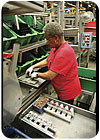
Demand for load centers is driven by new-home construction. The recent slowdown has elevated the plant's need for continuous improvement to an even higher level.
Successful Lean Initiative
The Lexington plant was one of the first Schneider Electric facilities in North America to adopt lean manufacturing initiatives. “Each of our facilities has its own personality,” says Engel. “Lexington is a plant that always strives to be No. 1. When they began to plateau on improvement implementations, they held extensive diagnostic events that set a new future state for the facility. They were not content with evolutionary improvements; they are seeking revolutionary improvements.”Employees have embraced many elements of the Schneider Production System (SPS), which is based on the Toyota Production System. It is comprised of 40 guiding principles organized around three domains: people commitment; product and process engineering; and the management of industrial and logistic processes that assure quality and customer satisfaction.
The SPS has a comprehensive set of lean categories and criteria that are assessed on an annual basis. These categories and their subsets are scored on a scale of 1 to 5, and focus on continuous flow production, material movement, process reliability, demand variability, lean supply change and continuous improvement.
Each of these categories and their subsets are assessed by corporate SPS auditors, and every area of the plant must implement them and show measurable improvement. In 2006, the Lexington plant received a 20 percent improvement over the previous year’s score.
Since 2002, the plant has averaged a 6.7 percent annual productivity improvement. “To deliver that savings, multiple manufacturing excellence diagnostics were conducted that drove either assembly process improvements or capital projects to utilize labor in a more efficient manner,” says Engel.
“Our challenge today is controlling variation in internal parts, external parts, equipment and variation from operator to operator,” adds Spence. “With as much automation as we have, slight variations in any of the above can wreak havoc in our manufacturing processes. We continue to train more employees in Six Sigma to understand and control our variation.”
The plant conducts regular kaizen events, with equal participation from management and plant floor personnel, to measure productivity and improve assembly processes. “We conduct several types of kaizen activities, which we call ‘diagnostics,’” explains Spence. “These detailed events can last from one to three weeks long.
“Last year, we conducted four, three-week long diagnostics: One on the plant layout, one for load centers, one for safety switches and one for fabrication,” notes Spence. “These diagnostics were wall-to-wall and started out with value-stream maps.
“Employees can initiate kaizen requests or help through our kaizen boards in each group,” adds Spence. “They put up ideas or requests that are studied and implemented in a team environment.”
One idea that came out of a recent kaizen event involved moving the load center cover riveting process closer to the fabrication department. “Value-stream maps were utilized for the event to reduce movement, waste and cycle time,” says Molinar. “Today, the cover rivet assembly process is directly across from the large tonnage presses that produce the two stamped parts required for cover riveting.”
Another lean initiative that has improved productivity involves visual management systems. The plant uses group-level short interval management (SIM) boards. For instance, safety performance visuals feature safety crosses that show the number of days worked with no recordable safety accidents. Other visuals depict cross-rotational training capabilities, root-cause analysis on repetitive production barriers utilizing an A3 form and by-hour production barrier logs.
“Prior to implementing SIM last year, production-related issues were reviewed and discussed the next day,” says Molinar. “Many issues, especially small repetitive issues, were not captured.
“By focusing on a much smaller time increment, one hour at a time, we have begun capturing, via documentation, production barriers that prevent us from achieving our takt time,” explains Molinar. “Many of these are minor issues, but collectively they can be large. After issues are captured, they are discussed in each value stream team at the start of a shift, then prioritized and worked to corrective action.”
New Technology Tools
Because it assembles high-volume, standard products, the Lexington plant is more automated than many other Square D facilities, which tend to build more engineered-to-order items, such as medium-voltage switch gear. The plant is also one of the company’s largest manufacturing facilities.Since 1995, a significant amount of capital has been invested to drive labor productivity, improve quality, increase capacity and reduce cycle time. The plant is currently installing a $4 million power-and-free conveyor system as a result of a kaizen event last year.
“Today, all of our unpainted outdoor load centers and all switches have to be manually palletized and moved via a fork truck to our paint line,” says Spence. “This represents more than 120 miles a day in fork truck traffic on just our top 25 part numbers.”
When the new conveyor system is operational in January, painted parts will be delivered directly to assembly workstations. Unpainted parts will be picked up at different load points along the one-mile-long conveyor that snakes through the plant, eliminating all the manual palletizing of product and greatly reduce internal fork truck traffic. “The production process will be improved, since the assembly operators at the first station will have the correct box presented to them in an ergonomic position,” says Spence.
Over the last three years, assembly processes have also been improved through the use of robots that perform palletizing, machine loading and part reorientation. “Robots perform work that is physically straining or could result in worker injury throughout the day,” explains Molinar. “Safety is our No. 1 priority.”
Robots are used to palletize finished products, which weigh 15 to 40 pounds. “For our residential load centers, we are palletizing one every 7.5 seconds,” Molinar points out. “The physical strain on an individual would be incredible, so we have automated these types of tasks with robots wherever possible.”
And, the 2007 Assembly Plant of the Year often uses home-grown automation solutions. “A recent example is a new palletizer robot for our 30/60A switch line,” says Molinar. “In lieu of going outside for a turnkey palletizer solution, our automation and controls department designed the solution, which included purchasing a SCARA robot.
“All controls, conveyors and guarding were designed, procured, assembled and installed utilizing internal labor,” notes Molinar. “This method saves money and usually provides a better solution than when done with an outside vendor.”
As the Schneider Electric/Square D Lexington plant begins its next half-century of operation, Spence believes the facility will continue to transform itself with the latest production technology. “With continued commitment to employee safety, customer satisfaction and community responsibility, we will continue to provide value,” he predicts. “The challenge is continuous improvement; something this facility has achieved over the past 50 years and something that will continue to be the goal for the next 50.”
Learn more about the 2007 Assembly Plant of the Year by clicking "Web Extra." A
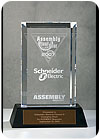
About the Award
The ASSEMBLY magazine “Assembly Plant of the Year” award was initiated in 2004 to showcase world-class production facilities in America, and the people, products and processes that make them successful. All manufacturers that assemble products in the United States are invited to nominate their plants.The goal of the award is to identify a state-of-the-art facility that has applied world-class processes to reduce production cost, increase productivity, shorten time to market or improve product quality.
An official nomination form was printed in several issues of ASSEMBLY earlier this year; in addition, an online version appeared on the magazine’s Web site (www.assemblymag.com). Nominations were received from a diverse group of manufacturers that reflect the magazine’s demographics.
All nominees were evaluated by a group of independent experts and by ASSEMBLY’s editorial staff, based on the following criteria:
Have assembly processes been improved through the use of new technology?
Has the plant improved its performance by making more effective use of existing technology?
Has the plant taken steps to reduce production costs?
Have new or improved assembly processes resulted in increased productivity?
Has the plant used assembly improvements to reduce time to market?
Has the plant boosted bottom-line profits and competitive advantage?
Did operators play a role in the successful implementation of new assembly strategies?
Has a product been effectively designed for efficient assembly?
Has the plant attempted to protect the environment and conserve natural resources?
As winner of the fourth annual Assembly Plant of the Year competition, Schneider Electric/Square D (Lexington, KY) received an engraved crystal award and a commemorative banner during a special presentation at the plant.
Previous recipients of the Assembly Plant of the Year award were Lear Corp. (Montgomery, AL), Xerox Corp. (Webster, NY) and Kenworth Truck Co. (Renton, WA). Nomination forms for the 2008 Assembly Plant of the Year award will be available early next year.
To view a video of the 2007 award presentation, tune into "ASSEMBLY TV."

